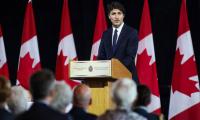HYDERABAD: According to camel herders, hailing from riverine area Budhani that was once a thick forested region in Matiari district, only a small number of clients come to buy these animals in Hyderabad’s sacrificial animals market.
Around 30 camels were brought for display in the open near main national highway Hyderabad city, with prices ranging from Rs150,000 to Rs250,000-Rs300,000, depending on animal health and size.
Muhammad Saleh Kori, a camel herder, has brought two pairs of camels for sale, and was waiting for clients. He has sold three young camels during one week, as he always comes late to the market, when Eid-ul Azha gets closer.
“For generations, we have a tradition of keeping large camel hers for breeding. We use their milk and earn a little income by selling the extra animals,” he said, adding that they collect fodder free of cost from neighbouring agriculture fields and do not need to invest more for its care.
“We have been bringing animals to the annual market for sale through generations,” he said, adding there were a few buyers, who purchased the animals for sacrifice.
Kori said they did not even have to bear the cost of food and fodder. “Boys bring two meals from the village daily for us and collect fodder and water for animals,” he explained.
Comparing this, he said, “When we went to Karachi a few years back, we had to bear a huge cost for transportation, food and fodder as well as the prescribed entry fees.” This was why he said they preferred bringing the animals to the market in Hyderabad.
“Since we are not traders waiting for profit, we are not in a hurry. We can sell the animals at reasonable prices and return back as usual,” he said.
Despite rains and heat they stay at the market to feed and take care of the camels. Whenever they see any client, only one or two persons deal with them for business.
According to the herders, the demand for camels in small cattle markets was not high. Larger animals have very few buyers.
Reports gathered from different weekly cattle markets in Sindh show that a few days back, before rains, the prices of animals went high, giving hope to traders of earning a good profit after a gap of four years. But the sudden arrival of monsoon rains forced traders and farmers to sell their animals hurriedly to avoid further loss.
Monsoon rains following extreme heat waves and humidity have disturbed trade at the weekly cattle markets in different small towns as well as major Karachi sacrificial animals market.
Muhammad Ramzan from Naushehro Feroz district, associated with trading precious breeds of cows, said, “It was after a four-year gap that traders thought they would get higher profit on their animals.”
Last year, people sold their cows or bullocks between Rs130,000 and Rs150,000. This year the rate of similar animals went high up to Rs200,000 or more in the Karachi cattle market.
Similarly, the price of a goat valued Rs30,000 last year, went high up to Rs60,000. Some traders purchased goats from small markets at low rates of Rs18000-20,000, which they sold at Rs38,000-40,000, with around 50 percent margin in prices, he said.
Ramzan witnessed an increase in animal prices compared to the previous years, but within no time the prices went down because of rains.
He said the number of animals arriving in the Karachi market this year was low compared to last year. That was why the prices went high in the beginning. But again the situation has changed and traders look disappointed.
Ranoo Khan, another trader from the same area, said they were hopeful of selling their animals at high prices before the rainfall.
“The price difference was drastic. Things changed within two-three days before and after rains,” he said,
He said farmers as always experience low prices at farms as well as in local markets, which was why they took animals to the market in Karachi. But this year too they were disappointed and faced losses when the value of the cattle declined after rains hit the province.
Mostly, traders hailing from Punjab and parts of Sindh and Balochistan bring animals to Karachi. As a result, they bear a huge cost of transportation and prescribed market entry fees with daily expenses of food for caretakers and fodder for animals.
Traders hire trailers carrying 30-40 animals each from Punjab, which charge Rs100,000 per vehicle. When prices decline, traders cannot afford to take the animals back and thus sell at whatever price they get.
Karachi cattle market did not attract many animals this year, compared to the previous years.
The same situation was witnessed at small markets in towns and cities of the province, where purchasers seem reluctant to pay the cost and waited to get a bargain once the weather changed.
Unfortunately, there is a lack of data when it comes to small cattle markets since a majority are informal and without a mechanism. Traders set up these markets wherever they please at their personal whims.
Bangul Mari, a farmer, said his family keeps goats for sale and has earned better profit this year. This happened because the demand for small animals is higher compared to larger ones.
An image from the MoU signing ceremony between Zindagi and PostEx.— LinkedIn@zindigi/File KARACHI: Zindigi, in...
The representational image shows a person holding gold necklaces. — AFP/FileKARACHI: Gold prices decreased by...
Makoto Uchida, president and CEO of Nissan Motor, and Toshihiro Mibe, Honda Motor president and CEO, attend their...
In this image, a man can be seen working in a textile factory in Pakistan. — AFP/FileLAHORE: The slow growth in...
Fishmonger Yasushi Miyamoto, 70, prepares local delicacy, bonito seared over a hay fire, in Ino, Kochi Prefecture,...
A representational image shows a person counting Rs5,000 notes. — AFP/FileKARACHI: The rupee extended losses against...







